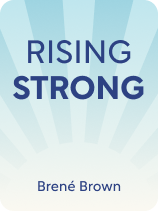
Have you had an emotional setback recently? Do you know how to recover emotionally?
Based on her research detailed in Rising Strong, Brené Brown argues that people who recover from emotional setbacks go through three stages. These stages are confronting your emotions, exploring what happened, and looking inward.
Let’s explore these stages and how to navigate them.
Stage #1: Confront Your Emotions
Brown argues that the first stage of learning how to recover emotionally is to recognize when you’re having an emotional setback and explore your reaction. With practice, you’ll be able to recognize a setback as it happens; however, at first, you may need to reflect on the experience retrospectively.
To recognize the start of an emotional setback, Brown says you must first notice negative sensations in your body and your mind. When we experience painful situations, our bodies and minds usually react first. For example, you might feel physical sensations like pain in your chest; or, mental sensations like impulsive thoughts or the inability to control your thoughts. When you notice these sensations, acknowledge that you’re having an emotionally painful reaction to something.
For example, when you got the message that your spouse wouldn’t be at your award ceremony, you might have experienced a sinking feeling in your stomach or the urge to hit something. When you feel these sensations begin, acknowledge that something has hurt you and you’re having an emotional setback.
Next, Brown advises you to explore your reaction. What are you feeling? What caused this reaction? For example, the bodily sensations you felt after receiving the message from your spouse might indicate that you’re feeling angry and disappointed. Upon reflecting, you might realize you’re angry because your spouse’s lack of attendance makes you feel unimportant.
Stage #2: Explore What Happened
Brown explains that the second stage of the recovery process is exploring your narrative about the situation and identifying how that narrative might differ from reality. When we experience something painful, our brains try to determine what happened and why in an attempt to avoid ambiguity. However, we don’t usually have all the important information about the situation—such as someone’s true feelings, intentions, or reasons. Therefore, we tend to assume the worst about what happened and why based on our negative past experiences. This creates an inaccurate narrative.
Relying on negative, inaccurate narratives often fosters negative feelings about ourselves and others. This keeps us from embracing our authentic selves, being open with others, and recovering wholeheartedness. For example, we might assume that someone’s intent was to hurt us or that they acted in a certain way because we weren’t good enough.
On the other hand, when we confront our narrative and its potential inaccuracies, we’re able to identify and combat our negative assumptions. This gives us a more balanced perspective of the situation and those involved in it so we’re better equipped to recover from setbacks and re-embrace wholeheartedness.
Further, learning to overcome these assumption reactions will boost your resilience—your ability to avoid or quickly recover from emotional setbacks in the future. This is because the more you practice deconstructing your inaccurate narratives, the easier it will get and the better you’ll become at preventing yourself from creating them in the first place.
Stage #3: Change Your Thoughts and Behaviors to Build Resilience
Brown explains that the final stage of the recovery process is to identify ways in which you can alter your thoughts and behaviors to avoid emotional setbacks in the future.
To complete this stage, consider: What new, more positive narratives do you need to tell yourself to avoid making negative assumptions about yourself or others? What emotional wounds and beliefs do you need to overcome to improve your relationships, strengthen your self-worth, and create a happier, more fulfilling life for yourself? Every time you experience a new emotional setback and move through the recovery process, ask yourself these questions and determine which wounds to heal next.
To move forward and build resilience, you must identify ways to lessen the control that your fear has over your thoughts and behaviors. You might do this by catching yourself when you assume ill-intent from someone and trying to see the situation from their perspective. Further, you could work on forming more realistic expectations of others. It may not be realistic or fair to expect your spouse to attend your ceremony if they’re sick—you need to consider their needs, not just your own.

———End of Preview———
Like what you just read? Read the rest of the world's best book summary and analysis of Brené Brown's "Rising Strong" at Shortform.
Here's what you'll find in our full Rising Strong summary:
- How to rebuild wholeheartedness after setbacks and recover emotionally
- Why you shouldn't try to push through or ignore emotional pain
- Brené Brown's three-stage recovery process to cultivate resilience






